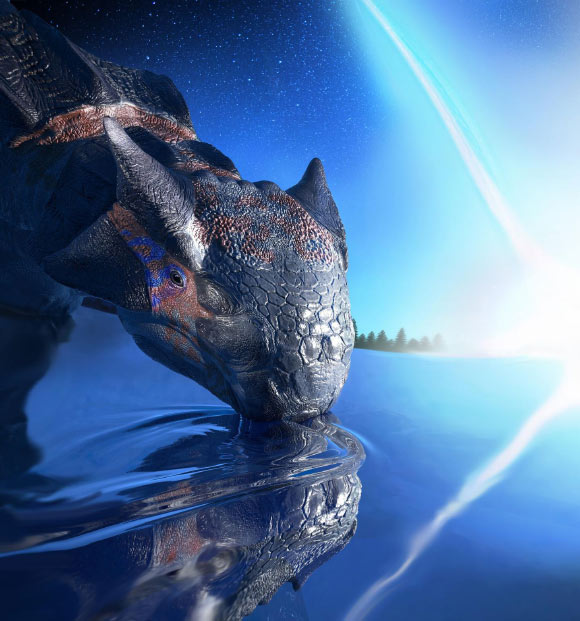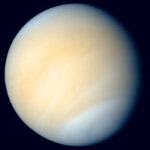The so-called Chicxulub impactor was a carbonaceous-type asteroid that had formed beyond the orbit of Jupiter, according to a new paper published in the journal Science.
Ankylosaurus magniventris, a large armored dinosaur species, witnesses the impact of an asteroid, falling on the Yucatan peninsula 66 million years ago. Image credit: Fabio Manucci.
About 66 million years ago, a 10-km-wide asteroid crashed into Earth near the site of the small town of Chicxulub in what is now Mexico.
The impact unleashed an incredible amount of climate-changing gases into the atmosphere, triggering a chain of events that led to the extinction of non-avian dinosaurs and 75% of life on the planet.
Evidence includes high levels of platinum-group elements (PGEs) like iridium, ruthenium, osmium, rhodium, platinum, and palladium in Cretaceous-Paleogene boundary layers, which are rare on Earth but common in meteorites.
These elevated PGE levels have been found globally, suggesting the impact spread debris worldwide.
While some propose large-scale volcanic activity from the Deccan Traps igneous province in India as an alternative source of PGEs, the specific PGE ratios at the Cretaceous-Paleogene boundary align more with asteroid impacts than volcanic activity.
However, much about the nature of the Chicxulub impactor — its composition and extraterrestrial origin — is poorly understood.
To address these questions, Dr. Mario Fischer-Gödde from the University of Cologne and his colleagues measured ruthenium isotopes in samples taken from three Cretaceous-Paleogene boundary sites.
For comparison, they also analyzed samples from five other impacts that occurred between 36 million to 470 million years ago; samples from ancient 3.5-billion- to 3.2-billion-year-old impact spherule layers; and samples from two carbonaceous meteorites.
They found that the ruthenium isotope signatures in samples from the Cretaceous-Paleogene boundary were uniform and closely matched those of carbonaceous chondrites, not Earth or other meteorite types, suggesting that the Chicxulub impactor likely came from a carbonaceous-type asteroid that formed in the outer Solar System.
The five other impact structures have isotopic signatures that are more consistent with siliceous-type asteroids, which formed closer to the Sun.
The ancient spherule layer samples are consistent with impacts of carbonaceous-type asteroids during Earth’s final stages of accretion.
“The asteroid’s composition is consistent with that of carbonaceous asteroids that formed outside of Jupiter’s orbit during the formation of the Solar System,” Dr. Fischer-Gödde said.
“We found that the impact of an asteroid like the one at Chicxulub is a very rare and unique event in geological time,” said University of Cologne’s Professor Carsten Münker.
“The fate of the dinosaurs and many other species was sealed by this projectile from the outer reaches of the Solar System.”
_____
Mario Fischer-Gödde et al. 2024. Ruthenium isotopes show the Chicxulub impactor was a carbonaceous-type asteroid. Science 385 (6710): 752-756; doi: 10.1126/science.adk4868




